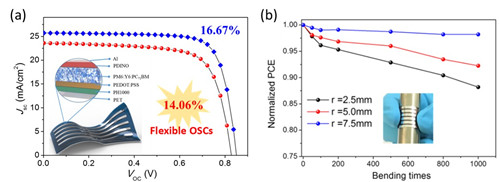Faced with the huge demand for energy and the increasingly serious environmental pollution problems, solar energy is an inexhaustible energy treasure house endowed by nature, and the new type of solar cell technology has received extensive attention. Organic solar cells (OSC) have many advantages such as light weight, ultra-thin, flexible, and easy to prepare in a large area, and have broad application prospects in the fields of portable, flexible batteries, and photovoltaic building energy supply.
Ge Ziyi's research group of Ningbo Institute of Materials Technology and Engineering, Chinese Academy of Sciences has made new progress in the field of organic solar cells. By increasing the length of the alkyl side chain on the seven-membered benzothiadiazole condensed ring Y6 non-fullerene receptor and regulating its molecular arrangement and solubility, a new small molecule receptor material BTP-4F-12 was synthesized . Using non-halogen solvent THF instead of chlorobenzene processing, the efficiency of the prepared single-block binary OSC reached 16.4%. The work was published in "Advanced Materials" with the title of Eco-compatible solvent processed organic photovoltaic cells with over 16% efficiency (Advanced Materials, 2019, 31, 1903441).
In addition, the research team adopted a ternary blending strategy, that is, by introducing the third component PC71BM in the binary system of wide band gap polymer donor PM6 and narrow band gap acceptor Y6, to further broaden the absorption range of the photoactive layer and optimize the film In terms of morphology, OSC prototype devices with single junction rigidity of 16.67% and flexible efficiency of 14.06% were obtained, which is currently the most publicly reported flexible OSCs with the highest efficiency. After 1000 times of continuous bending (bending radius r = 5.0 mm), the battery can still maintain 90% of the initial efficiency, showing very good bending resistance, which provides important guidance for the preparation of efficient OSC flexible devices. The work was published in "Advanced Materials" (Advanced Materials, 2019, 31, 1902210) with the title of 16.67% Rigid and 14.06% Flexible Organic Solar Cells Enabled by Ternary Heterojunction Strategy.
The above research was supported by the National Key R & D Program (2016YFB0401000), the National Natural Science Foundation of China (51773212, 21574144, 61705240, and 21674123), the Zhejiang Provincial Outstanding Youth Fund (LR16B040002), the Ningbo Science and Technology Innovation Team (2015B11002, 2016B10005), and the Chinese Academy of Sciences. Funded by the project (QYZDB-SSW-SYS030) and the key international cooperation project of the Chinese Academy of Sciences (174433KYSB20160065).

Figure 1 (a) Molecular structure, (b) JV curve, (c) 2D GIWAXS diagram of PBDBTF: BTP-4F-12 system, (d) EQE curve, and (e) photo-CELIV test structure

Figure 2 (a) Schematic diagram of battery structure and JV curve, (b) Efficiency change after bending test at different radii (r = 2.5, 5.0 and 7.5 mm)
Ningbo Wason Lighting Technology Co.,Ltd , https://www.wasonlight.com